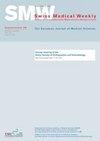Intravenous ferric carboxymaltose is associated with lowering of plasma phosphate levels in patients with gastric bypass surgery: a retrospective case series
IF 2.1
4区 医学
Q2 MEDICINE, GENERAL & INTERNAL
引用次数: 0
Abstract
AIMS: Bariatric surgery induces several micronutrient deficiencies that require supplementation. For iron, parenteral infusions are usually preferred over oral supplementation. Ferric carboxymaltose infusion has been associated with hypophosphataemia, mostly transient and asymptomatic. However, in some cases, ferric carboxymaltose-induced hypophosphataemia may persist for weeks to months and may induce muscle weakness, osteomalacia and bone fractures. The aim of this study was to identify possible predictors of a clinically relevant decrease in serum phosphate after ferric carboxymaltose infusion in patients with previous Roux-en-Y gastric bypass. METHODS: Patients with previous Roux-en-Y gastric bypass who received ferric carboxymaltose infusions between January 2018 and September 2019 and had recorded phosphataemia before and after ferric carboxymaltose infusion at the Lausanne University Hospital, Lausanne, Switzerland, were studied retrospectively. A multiple linear regression model was built with delta phosphataemia as the outcome to investigate the factors related to magnitude of serum phosphate lowering. RESULTS: Seventy-seven patients (70 females and 7 males) with previous Roux-en-Y gastric bypass were studied. Mean age (SD) was 43.2 (10.7) years and median BMI was 30.9 kg/m2 (IQR 27.9–36.4). Sixty-eight patients (88.3%) received an infusion of 500 mg ferric carboxymaltose and 9 patients (11.7%) received 250 mg ferric carboxymaltose. Forty-nine patients (63.6%) developed hypophosphataemia (<0.8 mmol/l) after ferric carboxymaltose infusion. Median plasma phosphate significantly decreased by 0.33 mmol/l (IQR 0.14–0.49) (p<0.0001). Multiple linear regression identified the ferric carboxymaltose dose as the only risk factor significantly associated with the magnitude of serum phosphate lowering, with an additional mean loss of 0.26 mmol/l with a 500 mg infusion compared to a 250 mg infusion (p = 0.020). CONCLUSION: Ferric carboxymaltose infusions substantially decreased plasma phosphate levels in patients with previous Roux-en-Y gastric bypass. Compared to a dose of 250 mg, infusion of a dose of 500 mg ferric carboxymaltose decreased the plasma phosphate further in this population.静脉注射羧甲基铁与降低胃旁路手术患者的血浆磷酸盐水平有关:回顾性病例系列研究
目的:减肥手术会导致多种微量元素缺乏,需要补充。就铁而言,肠外输注通常优于口服补充。羧甲基铁输注与低磷血症有关,大多为一过性和无症状。然而,在某些情况下,羧甲基亚铁引起的低磷血症可能会持续数周至数月,并可能诱发肌无力、骨软化症和骨折。本研究旨在确定既往接受过 Roux-en-Y 胃旁路术的患者在输注羧甲基亚铁后血清磷酸盐出现临床相关性下降的可能预测因素。方法:本研究对瑞士洛桑市洛桑大学医院在 2018 年 1 月至 2019 年 9 月期间接受过羧甲基亚铁输注并在输注羧甲基亚铁前后记录有磷血症的既往接受过 Roux-en-Y 胃旁路术的患者进行了回顾性研究。建立了一个以δ磷血症为结果的多元线性回归模型,以研究与血清磷酸盐降低幅度相关的因素。结果:研究了77名既往接受过Roux-en-Y胃旁路手术的患者(70名女性和7名男性)。平均年龄(标清)为 43.2 (10.7)岁,体重指数中位数为 30.9 kg/m2 (IQR 27.9-36.4)。68 名患者(88.3%)输注了 500 毫克羧甲基亚铁,9 名患者(11.7%)输注了 250 毫克羧甲基亚铁。输注羧甲基亚铁后,49 名患者(63.6%)出现了低磷血症(<0.8 毫摩尔/升)。血浆磷酸盐中位数明显降低了 0.33 mmol/l(IQR 0.14-0.49)(p<0.0001)。多元线性回归发现,羧甲基亚铁剂量是唯一与血清磷酸盐降低幅度显著相关的风险因素,与 250 毫克输注相比,500 毫克输注的平均磷酸盐降低了 0.26 毫摩尔/升(p = 0.020)。与 250 毫克剂量相比,输注 500 毫克羧甲基亚铁可进一步降低该人群的血浆磷酸盐水平。
本文章由计算机程序翻译,如有差异,请以英文原文为准。
求助全文
约1分钟内获得全文
求助全文
来源期刊

Swiss medical weekly
医学-医学:内科
CiteScore
5.00
自引率
0.00%
发文量
0
审稿时长
3-8 weeks
期刊介绍:
The Swiss Medical Weekly accepts for consideration original and review articles from all fields of medicine. The quality of SMW publications is guaranteed by a consistent policy of rigorous single-blind peer review. All editorial decisions are made by research-active academics.
 求助内容:
求助内容: 应助结果提醒方式:
应助结果提醒方式:


